
Widely known as a country with beautiful landscapes, 98% of the land mass in Scotland is considered rural. Easily recognisable for the rolling highlands and expansive lochs, the country has seemingly endless outdoor locations, making sense of the fact that a mere 17% of the Scottish population lives in authentic natural green spaces.
As with any predominantly rural area, Scotland is home to a number of species of animal, both on land and in Scottish waters. From many thousands of bird species in the skies, freshwater fish in the water and numerous mammals in Scotland’s forests, the country contains a mix of species you are aware of and other species that you may not even realise are present in Scotland.
In our guide on Scottish wildlife, Arbtech provides a comprehensive insight into the country’s natural environment and the animal species that live there.
Wildlife in Scotland
Across Scotland, there are around 90,000 species of animal, including four reptile species, six amphibian species and countless invertebrate species spanning into the tens of thousands.
Below, we have provided insight into the unique nature of Scottish wildlife with facts on just a small number of the species present:
Scottish Wildlife Facts
- Adders are widely spread across Scotland and feature as the only poisonous species of snake in the country.
- Although not commonly known for either species, whales and dolphins are often spotted in the summer, primarily off the Scottish coast on the Isle of Mull and the Isle of Skye.
- An estimated 12% of the UK’s entire population of otters live on the Shetland Islands.
- The grey seal and harbour seal are two primary species of seal in Scotland, with the harbour seal able to swim up to 200 metres underwater and remain submerged for up to 15 minutes.
- In the peak of the season, Bass Rock sees around 150,000 gannets.
- Scottish wildcats are so rare that there are now only approximately 100 left in the wild.
What Wildlife is in Scotland?
The vast countryside of Scotland acts as a haven for various wildlife species, with opportunities for amphibians, birds, invertebrates, mammals, reptiles and marine life to form viable habitats.
Not only is there a diverse selection of animal species, but they also appear in an array of locations. For instance, the common seal is present on the West Coast, beavers occupy the River Tay, Scottish crossbill feature in the Caledonian Forests, red grouse appear in Orkney, Shetland and the Outer Hebrides, and sightings of red kites have been recorded in Argaty and Galloway.
In the section below, examples of rare or protected wild animals in Scotland are detailed, split between two species categories of animals commonly found in the Scottish Highlands and other locations.
Wildlife in the Scottish Highlands
Scottish Highland Cow
Horned and with long shaggy hair, highland cows are iconic in Scottish culture, often appearing as a symbol of the country. Although the name suggests that they appear solely in the highlands, the highland cow has been spotted in multiple countryside parts of Scotland, as well as outside of Scotland in Europe, Australia and the Americas.
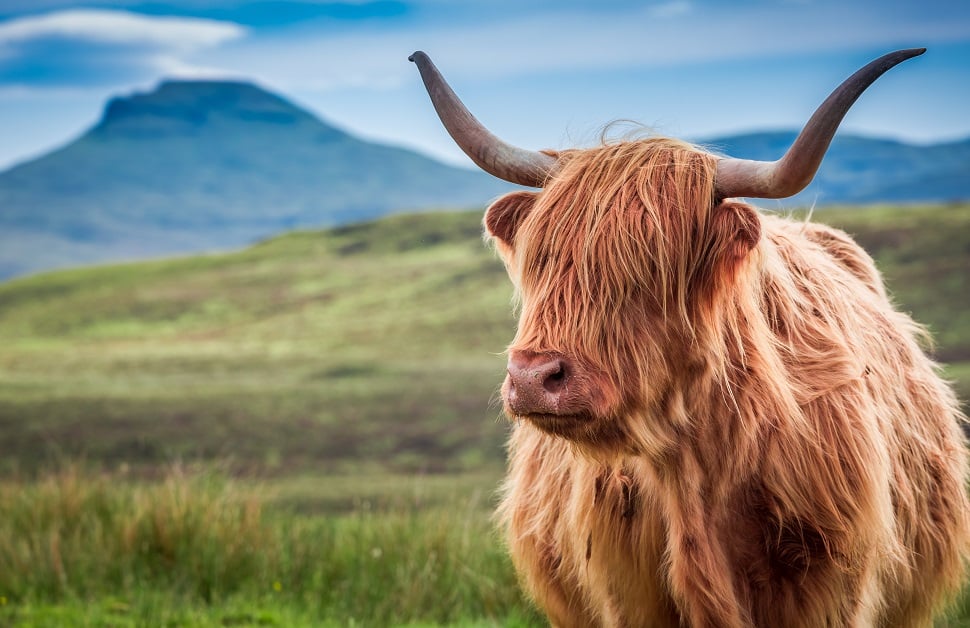
More often than not, highland cows are a red or ginger colour, but with others a tan, white, grey or black colour. Known as a peaceful and gentle breed of cow, they have an undercoat and an oily outer coat, giving them additional heat and allowing them to grow more hair during the winter months and less during the summer months
Scottish Wildcat
Donning distinctive black and brown stripes, Scottish wildcats are similar in appearance to domestic cats but twice the size, far more volatile and carrying much thicker fur. Alike domestic cats, the Scottish wildcat has advanced hearing, night vision, retractable claws and an athletic body for running, climbing and pouncing.
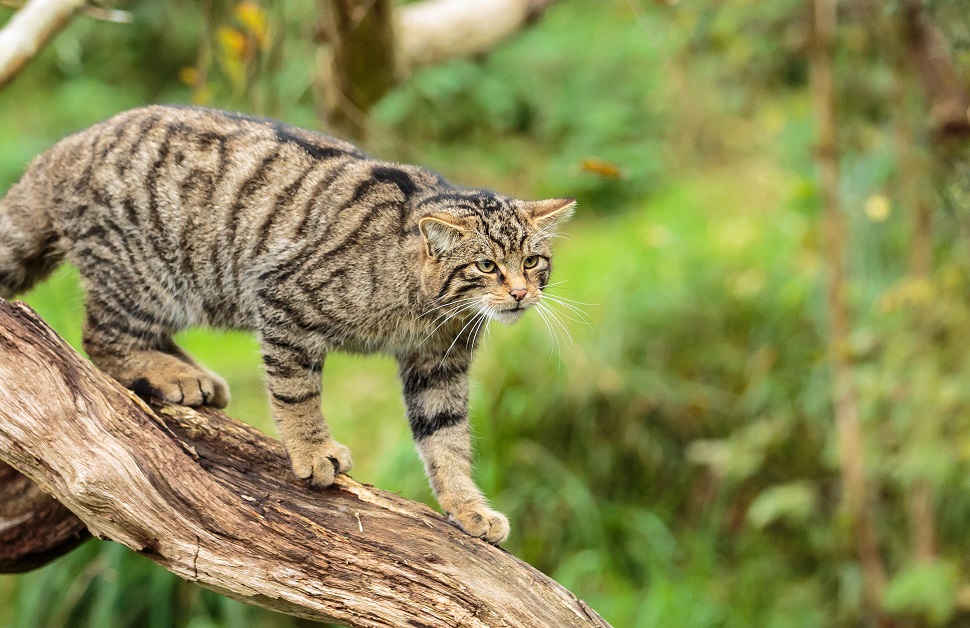
Aside from during breeding season, Scottish wildcats are solitary creatures. As previously mentioned, population numbers are dwindling. According to conservation group Saving Wildcats, the primary threat to Scottish wildcats has been interbreeding with feral cats that carry deadly diseases such as Feline HIV (FIV) and Feline Leukaemia (FeLV).
Scottish Golden Eagle
Ranked as the deadliest predator in the country, Scottish golden eagles are one of the UK’s 15 birds of prey. A distinctly large bird with a wide wing span, the golden eagle is only slightly smaller than the much rarer white-tailed eagle – the largest of all birds of prey in the UK.
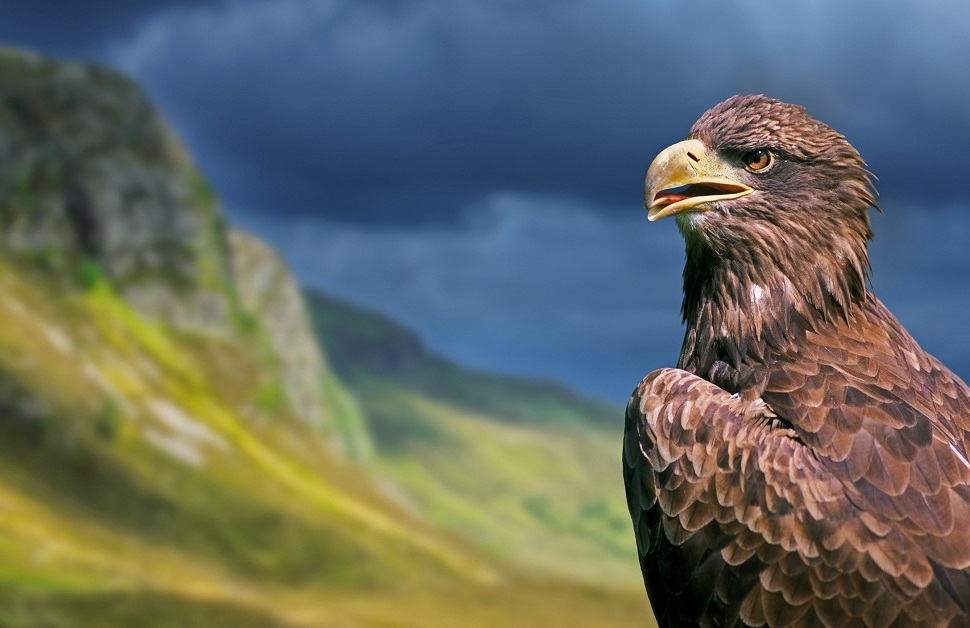
While golden eagles often target rabbits and hares, they have also been known to hunt foxes, birds and young deer. The chosen nest site of the golden eagle is usually in trees and on the faces of rocky cliffs, giving them the resources and positioning to create a giant nest for themselves, the golden eagle they’ve paired for life with, and future generations of offspring.
Scottish Pine Marten
A part of the weasel family, pine martens are a rare species of animal that inhabit hillside and woodland parts of Scotland, including Dumfries, Galloway and the Scottish Borders. Similar in stature to a domestic cat, the pine marten has a dark brown body and a large tan patch that spans from their chin to their chest.

Following a surge in hunting activities involving the species, pine martens endured a concerning drop in population numbers in the 19th century. Recovering since, the estimated population now stands at 3,700, and since they were given legal protection in 1988, the restrictions have made it harder for anyone to cause harm to them.
Scottish Red Squirrel
Primarily present in coniferous woodland, Scottish red squirrels are similar in appearance to grey squirrels, but smaller, with red or brown fur and distinctive tufts of hair at the top of each ear. As well as the Lake District, Northumberland and numerous parts of South England and Wales, the red squirrel occupies Scotland more than anywhere else in the British Isles, equating to 75% of the species’ entire UK population.

Even with occupancy in various locations, groups like Saving Scotland’s Red Squirrels have campaigned to protect them. As population numbers of the non-native grey squirrel have grown, the population numbers of the red squirrel have fallen, partly caused by the transmission of squirrel pox from the immune grey squirrel to the at-risk red squirrel.
Scottish Red Deer
The largest breed of deer in Scotland, the Scottish red deer has large antlers that increase in size as they age, reach around a metre in width, and weigh up to 15 kilograms. Inhabiting moorlands and mountainsides, red deer are dark brown in colour with comparatively lighter patches of colour on their rump, tail and face.
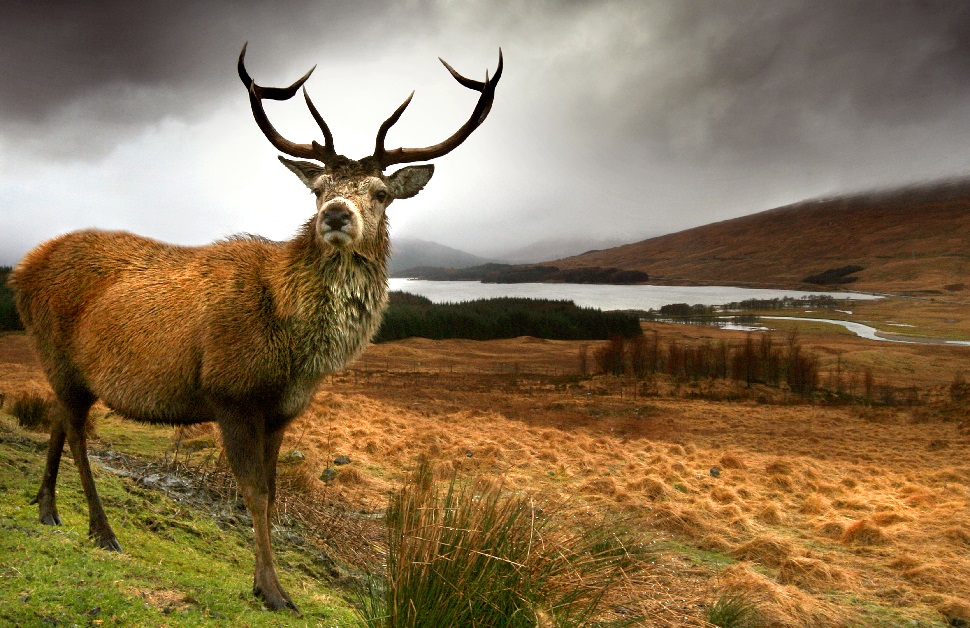
Due to their behaviour individually and in herds, red deer stags can be extremely dangerous. The season for breeding is known as rutting season, and at this point, male red deer will outline their territory and fight other males to win female mating partners, causing potentially fatal damage during battle from impact and stab wounds caused by their antlers.
Scottish Capercaillie
Usually spotted in the oakwoods and pinewoods of Scotland, the capercaillie is the largest breed of game bird. Featuring distinctive colours, male capercaillie are primarily grey but with a blue head and neck, green breast, red or brown wings and white patches on their shoulders. Some also have beards that appear more prominent during courtship displays.

When it comes to finding a mate, they use their long tail to put on a display to females, pointing their wings downwards, flaring their tails and bristling their beards while producing an array of sounds to ward off other males and entice females, who will lay between five to 12 eggs in each reproductive season.
Other Scotland Wildlife
Clowning Puffin
Also known as the Atlantic puffin due to originating from the coast of North America, clowning puffins are a small form of auk – a family of birds that also includes auklets, guillemots, murrelets and murres. The clown reference comes from the clowning puffin having a brightly coloured bill, helped by a waddling walk and often landing awkwardly after flight.
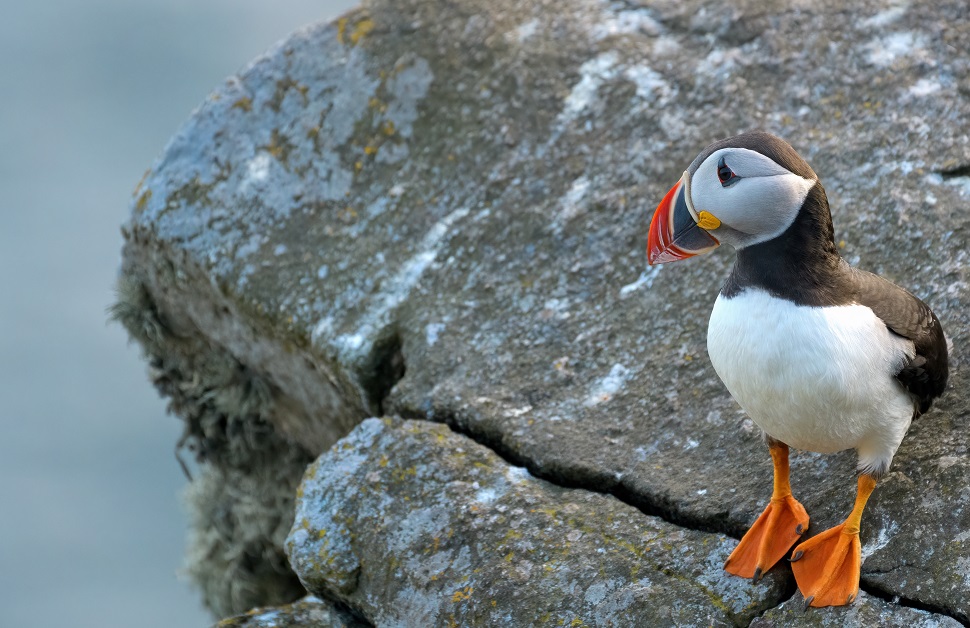
Alongside their vibrant bills, puffins are black and white with bright orange webbed feet. They live within burrows in the grass at the top of cliffs, diving into the sea below to catch fish. For the majority of the year, clowning puffins are at sea, returning to land to breed through locking bills with a chosen mate.
Dolphin
Although an unexpected species to see in the UK, bottlenose dolphins are present in certain parts of Britain, including Moray Firth in Scotland. Sharing a similar appearance to other types of dolphins, the bottlenose dolphin is large and grey, with a backwardly curved dorsal fin and a short beak.
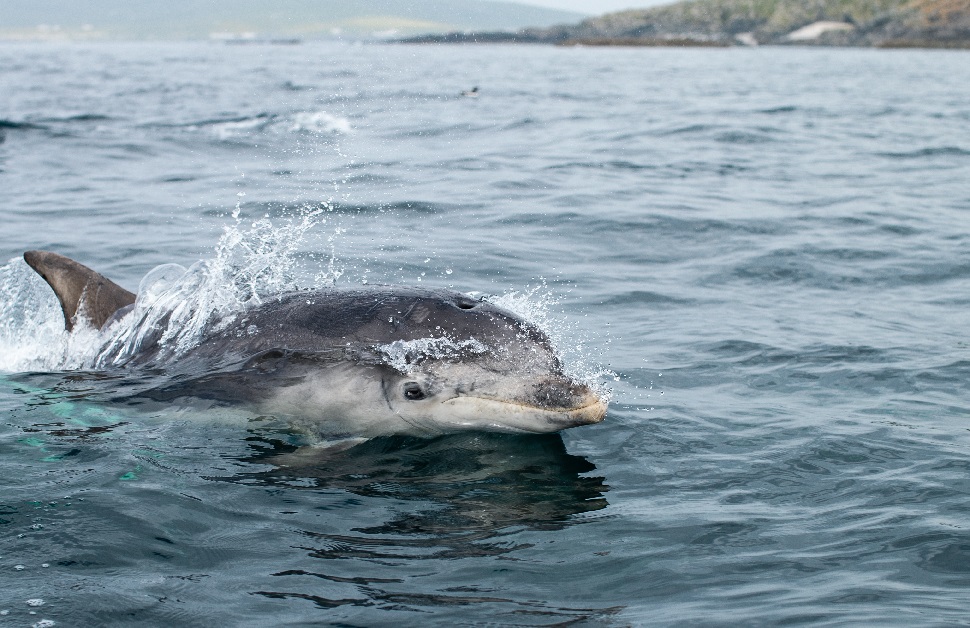
Using their strong and athletic physique, they are capable of jumping out of the water and moving as fast as 30 kilometres per hour, assisting with catching fish. Calm in temperament, bottlenose dolphins are known as social animals and are usually found in small groups. Other underwater creatures in Scotland include the humpback whale, killer whale and basking sharks.
Impact of Humans on Scottish Wildlife
Multiple factors can affect the wildlife present in Scotland, including grazing pressure and interference from harmful elements such as diseases, pests and invasive species of plants. Humans also play a significant role in impacting wildlife, particularly in changes to land use caused by development projects.
Both Scotland’s land and property developments can disturb local wildlife, with land developments affecting a natural habitat situated on a greenfield site and property developments interfering with Scottish wildlife species that inhabit buildings and urban areas.
Protecting Scotland Wildlife
For wildlife across Scotland to be sufficiently safeguarded, responsible bodies need to regulate and restrict the actions of anyone who could cause harm to them. The Scottish government provide protection over animal species that are considered rare or vulnerable in a number of ways.
The key aims of the government include ensuring animal management in a fair and humane way, coordinating police enforcement on wildlife crime, intervening in any conflicts between individuals and wildlife, and preventing cruel or inappropriate activities involving wildlife.
Part of what enhances the Scottish government’s wildlife management coverage is the collaboration with knowledgeable experts. For instance, NatureScot (formerly Scottish Natural Heritage) act as an advisory body on nature, wildlife and the landscape, and registered charity organisations the Scottish Wildlife Trust and the National Trust also offer support to native animal species, both in partnership with the government and independently.
Wildlife Legislation in Scotland
Legislation designed to protect wildlife that applies to the United Kingdom (England, Scotland and Wales) includes:
- The Conservation (Natural Habitats) Regulations 1994
- The Control of Trade In Endangered Species (Enforcement) Regulations 1997
- The Protection of Badgers Act 1992
- The Wildlife and Countryside Act 1981
- The Wild Mammals (Protection) Act 1996
Additionally, in Scotland alone, legislation to specifically protect Scottish wildlife includes:
- The Deer Act 1996
- The Nature Conservation Act 2004
- The Protection of Wild Mammals Act 2002
- The Salmon and Freshwater Fisheries (Consolidation) Act 2003
Showing Consideration to Scotland Wildlife
Developers are required to show evidence of demonstration to practical conservation before the local planning authority will consider granting an application for planning permission. On-site assessments will allow for ecologists to conduct research on the specific plot of land and carry out a site visit as part of an ecology survey on present animal and plant habitats.
Operating exclusively under best practice guidelines and with a determination to offer a universally high standard of service to all clients, our ecological consultants will attend the site at the best time based on the animal’s behaviours to undertake the assessment. With ecological surveyors situated all over the British Isles, we can cover inspections on several species of animals and plants for development sites in Scotland.
All you need to do is speak to our team using our contact details over the phone or via email, give us information about your site, and keep your eyes on your emails for the free quote we send to you. You can then decide whether or not you would like to move forward with us, and if you would, we can begin the ecological survey process and help you to mitigate for potentially rare or protected species on your site.

There are no comments yet. Why not get involved?